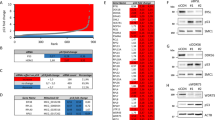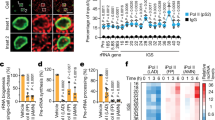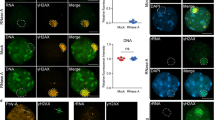Abstract
Werner syndrome (WS) is a rare autosmomal recessive genetic disorder causing premature aging. The gene (WRN) responsible for WS encodes a protein homologous to the RecQ-type helicase. WRN has a nucleolar localization signal and shows intranuclear trafficking between the nucleolus and the nucleoplasm. WRN is recruited into the nucleolus when rRNA transcription is reactivated in quiescent cells. Inhibition of mRNA transcription with α-amanitin has no effect on nucleolar localization of WRN whereas inhibition of rRNA transcription with actinomycin D releases WRN from nucleoli, suggesting that nucleolar WRN is closely related to rRNA transcription by RNA polymerase I (RPI). A possible function of WRN on rRNA transcription through interaction with RPI is supported by the results described here showing that WRN is co-immunoprecipitated with an RPI subunit, RPA40. Here we show that WS fibroblasts are characterized by a decreased level of rRNA transcription compared with wild-type cells, and that the decreased level of rRNA transcription in WS fibroblasts recovers when wild-type WRN is exogenously expressed. By contrast, exogenously expressed mutant-type WRN lacking an ability to migrate into the nucleolus fails to stimulate rRNA transcription. These results suggest that WRN promotes rRNA transcription as a component of an RPI-associated complex in the nucleolus.
This is a preview of subscription content, access via your institution
Access options
Subscribe to this journal
Receive 50 print issues and online access
$259.00 per year
only $5.18 per issue
Buy this article
- Purchase on Springer Link
- Instant access to full article PDF
Prices may be subject to local taxes which are calculated during checkout





Similar content being viewed by others
References
Balajee AS, Machwe A, May A, Gray MD, Oshima J, Martin GM, Nehlin JO, Brosh R, Orren DK, Bohr VA . 1999 Mol. Biol. Cell 10: 2655–2668
Brosh Jr RM, Orren DK, Nehlin JO, Ravn PH, Kenny MK, Machwe A, Bohr VA . 1999 J. Biol. Chem. 274: 18341–18350
Cheng RZ, Murano S, Kurz B, Shmookler Reis RJ . 1990 Mutat Res. 237: 259–269
Constantinou A, Tarsounas M, Karow JK, Brosh RM, Bohr VA, Hickson ID, West SC . 2000 EMBO Reports 1: 80–84
Cooper MP, Machwe A, Orren DK, Brosh RM, Ramsden D, Bohr VA . 2000 Genes Dev. 14: 907–912
Dammann R, Pfeifer GP . 1998 Biochem. Biophys. Acta 1396: 153–157
Epstein CJ, Martin GM, Schultz AL, Motulsky AG . 1966 Medicine 45: 177–221
Faragher RG, Kill IR, Hunter JA, Pope FM, Tannock C, Shall S . 1993 Proc. Natl. Acad. Sci. USA 90: 12030–12034
Finkelstein A, Kostrub CF, Li J, Chavez DP, Wang BQ, Fang SM, Greenblatt J, Burton ZF . 1992 Nature 355: 464–467
Fukuchi K, Martin GM, Monnat Jr RJ . 1989 Proc. Natl. Acad. Sci. USA 86: 5893–5897
Gangloff S, McDonald JP, Bendixen C, Arthur L, Rothstein R . 1994 Mol. Cell. Biol. 14: 8391–8398
Gray MD, Wang L, Youssourfian H, Martin GM, Oshima J . 1998 Exp. Cell Res. 242: 487–494
Huang S, Li B, Gray MD, Oshima J, Mian IS, Campisi J . 1998 Nat. Genet. 20: 114–116
Kadener S, Cramer P, Nogues G, Cazalla D, de La Mata M, Fededa JP, Werbajh SE, Srebrow A, Kornblihtt AR . 2001 EMBO J. 20: 5759–5768
Kamath-Loeb AS, Johansson E, Burgers PM, Loeb LA . 2000 Proc. Natl. Acad. Sci. USA 97: 4603–4608
Kamath-Loeb AS, Shen JC, Loeb LA, Fry M . 1998 J. Biol. Chem. 273: 34145–34150
Kitao S, Lindor NM, Shiratori M, Furuichi Y, Shimamoto A . 1999 Genomics 61: 268–276
Lebel M, Leder P . 1998 Proc. Natl. Acad. Sci. USA 95: 13097–13102
Lebel M, Spillare EA, Harris CC, Leder P . 1999 J. Biol. Chem. 274: 37795–37799
Lee S-K, Johnson RE, Yu S-L, Prakash L, Prakash S . 1999 Science 286: 2339–2342
Lombard DB, Beard C, Johnson B, Marciniak RA, Dausman J, Bronson R, Buhlmann JE, Lipman R, Curry R, Sharpe A, Jaenisch R, Guarente L . 2000 Mol. Cell. Biol. 20: 3286–3291
Marciniak RA, Lombard DB, Johnson FB, Guarente L . 1998 Proc. Natl. Acad. Sci. USA 95: 6887–6892
Matsumoto T, Imamura O, Yamabe Y, Kuromitsu J, Tokutake Y, Shimamoto A, Suzuki N, Satoh M, Kitao S, Ichikawa K, Kataoka H, Sugaware K, Thomas W, Mason B, Tsuchihashi Z, Drayna D, Sugawara M, Sugimoto M, Furuichi Y, Goto M . 1997a Hum. Genet. 100: 123–130
Matsumoto T, Shimamoto A, Goto M, Furuichi Y . 1997b Nat. Genet. 16: 335–336
Miyake S, Makimura M, Kanegae Y, Harada S, Sato Y, Takamori K, Tokuda C, Saito I . 1996 Proc. Natl. Acad. Sci. USA 93: 1320–1324
Mushegian AR, Bassett Jr DE, Boguski MS, Bork P, Koonin EV . 1997 Proc. Natl. Acad. Sci. USA 94: 5831–5836
Niwa H, Yamamura K, Miyazaki J . 1991 Gene 108: 193–199
Rong L, Palladino F, Aguilera A, Klein HL . 1991 Genetics 127: 75–85
Rong L, Klein HL . 1993 J. Biol. Chem. 268: 1252–1259
Salk D, Au K, Hoehn H, Martin GM . 1981 Cytogenet. Cell. Genet. 30: 92–107
Salk D, Bryant E, Hoehn H, Johnston P, Martin GM . 1985 Adv. Exp. Med. Biol. 190: 305–311
Shen JC, Gray MD, Oshima J, Kamath-Loeb AS, Fry M, Loeb LA . 1998 J. Biol. Chem. 273: 34139–34144
Shen JC, Loeb LA . 2000 Trends Genet. 16: 213–220
Shiratori M, Sakamoto S, Suzuki N, Tokutake Y, Kawabe Y, Enomoto T, Sugimoto M, Goto M, Matsumoto T, Furuichi Y . 1999 J. Cell Biol. 144: 1–9
Sinclair DA, Mills K, Guarente L . 1997 Science 277: 1313–1316
Smider V, Rathmell WK, Lieber MR, Chu G . 1994 Science 266: 288–291
Smith SD, Oriahi E, Lowe D, Yang-Yen HF, O'Mahony D, Rose K, Chen K, Rothblum LI . 1990 Mol. Cell. Biol. 10: 3105–3116
Stein GH, Yanishevsky R . 1994 Meth. Enzymol. 58: 279–292
Suzuki N, Shimamoto A, Imamura O, Kuromitsu J, Kitao S, Goto M, Furuichi Y . 1997 Nucleic Acids Res. 25: 2973–2978
Suzuki T, Shiratori M, Furuichi Y, Matsumoto T . 2001 Oncogene 20: 2551–2558
Suzuki N, Shiratori M, Goto M, Furuichi Y . 1999 Nucleic Acids Res. 27: 2361–2368
Watt PM, Louis EJ, Borts RH, Hickson ID . 1995 Cell 81: 253–260
Watt PM, Hickson ID, Borts RH, Louis EJ . 1996 Genetics 144: 935–945
Yu C-E, Oshima J, Fu YH, Wijsman EM, Hisama F, Alisch R, Matthews S, Nakura J, Miki T, Ouais S, Martin GM, Mulligan J, Schellenberg GD . 1996 Science 272: 258–262
Acknowledgements
The authors would like to thank Lawrence I Rothblum at Sigfried and Janet Weis Center for Research, the Geisinger Clinic in USA for his generous gift of anti-A127, anti-A194 and anti-RAP74 antibodies. We would like to acknowledge Martin Lavin at Queensland Institute of Medical Research in Australia for critically reading the manuscript. This study was supported by the Drug Organization (The Organization for Drug ADR Relief, R and D Promotion and Product Review) of the Japanese Government.
Author information
Authors and Affiliations
Corresponding author
Rights and permissions
About this article
Cite this article
Shiratori, M., Suzuki, T., Itoh, C. et al. WRN helicase accelerates the transcription of ribosomal RNA as a component of an RNA polymerase I-associated complex. Oncogene 21, 2447–2454 (2002). https://doi.org/10.1038/sj.onc.1205334
Received:
Revised:
Accepted:
Published:
Issue Date:
DOI: https://doi.org/10.1038/sj.onc.1205334
Keywords
This article is cited by
-
HERC2 inactivation abrogates nucleolar localization of RecQ helicases BLM and WRN
Scientific Reports (2021)
-
WRN modulates translation by influencing nuclear mRNA export in HeLa cancer cells
BMC Molecular and Cell Biology (2020)
-
Keeping ribosomal DNA intact: a repeating challenge
Chromosome Research (2019)
-
The nucleolus: a central response hub for the stressors that drive cancer progression
Cellular and Molecular Life Sciences (2019)
-
NAD+ augmentation restores mitophagy and limits accelerated aging in Werner syndrome
Nature Communications (2019)



